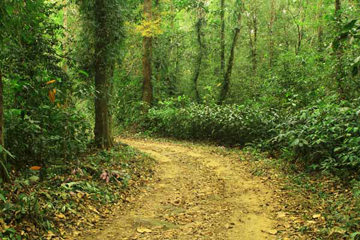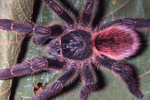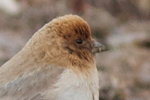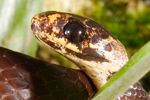
A female Polypedates ranwellai. Photo courtesy of Mendis Wickramasinghe.
Sri Lanka, an island country lying off the southeast coast of India, has long been noted for its vast array of biodiversity. Islands in general are renowned for their weird and wonderful creatures, including high percentages of endemic species—and Sri Lanka, where scientists recently discovered a new frog species, is no exception.
Sri Lanka harbors one of the greatest concentrations of amphibians in relation to area on the planet. There are 105 species of amphibians in Sri Lanka and 89 of these (85 percent) are endemic to the island, i.e. found no-where-else in the world. It is no surprise then that Sri Lanka has unveiled yet another of its secrets: a new, rare, and endemic frog.
Scientists discovered the Ranwella’s spined tree frog (Polypedates ranwellai) in the country’s Gilimale Forest. The frog was first observed in 2000, but only recently have specimens been subjected to “rigorous scientific processes” in order to establish that it is a new species. Leading researcher Mendis Wickramasinghe said the frog was named after Dr. Sanjeewa Ranwella in honor of his exceptional dedication towards wildlife conservation in Sri Lanka.
 Forest where the new frog species was discovered. Photo courtesy of Mendis Wickramasinghe. |
Tentatively categorized under the genus Polypedates, the species is believed to be a totally new species due to its skeletal deviations.
“Its skull possesses some unique osteological features. There are bony protrusions right behind its jaw and four at the back of its skull,” says Wickramasinghe.
Apart from the physical attributes of the frog, very little is known about this, thought to be, endemic species.
“Not much on its ecology is known apart from the breeding behaviour (which is incomplete) we observed just once, since the species is found to be highly seasonal and very rare,” Wickramasinghe said.
Sri Lankan amphibians are currently undergoing a treacherous time; over half are listed as Critically Endangered, Endangered, Vulnerable or Near Threatened, while 20 percent have been listed as extinct by the IUCN.
The habitat of Polypedates ranwellai is already under threat. Sri Lanka has been ravaged by habitat loss as human populations have boomed.
“Forest fragmentation has become the major threat in this area due to the fast rate of deforestation,” explains Wickramasinghe. “Many isolated forest patches that existed in the area have disappeared in the last five years, having been cleared and converted to human settlements. Forest patches are also
being cleared and converted to small tea plantations.”
Intense deforestation has meant that Sri Lanka has only 2-3 percent of its primary forest remaining. Even the remaining forest is patchily distributed.
On top of the increasing threat of deforestation, further habitat loss looms large with the proposal of the construction of a large dam, which would engulf the Gilimale Forest reserve. Logging and hazardous activities such as gem mining, sand mining, use of agro chemicals, cutting down and setting fires in the forest edge also pose considerable threats.
Asked if there were any conservation actions in place in this area of Sri Lanka, Wickramasinghe said “there are none, it is one of the least protected areas in the island.”
The reality is that on-going issues surrounding conservation in this region of Sri Lanka not only threaten the existence of the only known population of Polypedates ranwellai in the world, but many other species along with it. The region is also home to the Endangered and endemic Sri Lankan leopard (Panthera pardus kotiya), the Endangered Asian elephant (Elephas maximus), the Vulnerable sloth bears (Melursus ursinus), and Indian flying foxes (Pteropus giganteus).
Currently, around 13 percent of terrestrial land in Sri Lanka is protected, but pesticides, pollution and growing agriculture are accumulating in the countries’ most important ecosystems.

A male Polypedates ranwellai calling. Photo courtesy of Mendis Wickramasinghe.
CITATION: L.J. Mendis Wickramasinghe, D.A.I. Munindradasa, Prithiviraj Fernando. A new species of Polypedates Tschudi (Amphibia, Anura, Rhacophoridae) from Sri Lanka. Zootaxa 3498: 63–80 (2012).
Related articles
Happy Halloween: nine new species of tree-climbing tarantula discovered

(10/31/2012) If you suffer from acute arachnophobia, this is the perfect Halloween discovery for you: a spider expert has discovered nine new species of arboreal (tree-dwelling) tarantulas in the Brazil. Although tarantula diversity is highest in the Amazon rainforest, the new species are all found in lesser-known Brazilian ecosystems like the Atlantic Forest, of which less than 7 percent remains, and the cerrado, a massive savannah that is being rapidly lost to agriculture and cattle ranching.
Photo: high-altitude bird rediscovered after 80 years

(10/29/2012) In 1929 the U.S. Stock Market collapsed, the Geneva Convention set standards for prisoners of war, the first Academy Awards was celebrated, and Jérôme Alexander Sillem collected two bird specimens on a high plateau in Xinjiang, China. For 62 years, the specimens sat in a drawer at the Zoological Museum of Amsterdam until C. S. Roselaar found them, studied them, and determined they, in fact, represented a new species of bird: Sillem’s mountain finch (Leucosticte sillemi). Now, 83 years after Sillem collected the only known specimens, a French photographer, Yann Muzika, unwittingly took photographic proof that the finch species still survives.
Photos: new mammal menagerie uncovered in remote Peruvian cloud forest

(10/03/2012) Every year scientists describe around 18,000 new species, but mammals make up less than half a percent of those. Yet mammal surprises remain: deep in the remote Peruvian Andes, scientists have made an incredible discovery: a rich cloud forest and alpine grassland ecosystem that may be home to no less than eight new mammal species. Although most of these new mammals are currently under study—and have not been officially described yet (a process which can take several years)—lead scientists, Horacio Zeballos of Peru and Gerardo Ceballos of Mexico are certain they have uncovered a small forest, surrounded by deforestation and farmland, that shelters a remarkable menagerie of mammals unknown to scientists until now.
Scientists name new snake species to criticize mine plans in Panama (photos)

(09/18/2012) While scientists increasingly name new species after celebrities in order to gain much-needed attention for the world’s vanishing biodiversity, researchers describing a new snake species from Panama have taken a different route. Dubbing the new serpent, Sibon noalamina (‘no to the mine!’ in Spanish), the scientists are hoping the multicolored snake’s unusual name will draw attention to mining and deforestation issues in Panama’s remote Tabasará mountains.
Remarkable new monkey discovered in remote Congo rainforest

(09/12/2012) In a massive, wildlife-rich, and largely unexplored rainforest of the Democratic Republic of the Congo (DRC), researchers have made an astounding discovery: a new monkey species, known to locals as the ‘lesula’. The new primate, which is described in a paper in the open access PLoS ONE journal, was first noticed by scientist and explorer, John Hart, in 2007. John, along with his wife Terese, run the TL2 project, so named for its aim to create a park within three river systems: the Tshuapa, Lomami and the Lualaba (i.e. TL2), a region home to bonobos, okapi, forest elephants, Congo peacock, as well as the newly-described lesula.
Tiny new frog discovered in India bypasses the free-swimming tadpole stage
(09/07/2012) A tiny new frog species has been discovered in the rainforests of India’s Western Ghats.
Unidentified poodle moth takes Internet by storm

(08/29/2012) A white moth from Venezuela that bears a striking resemblance to a poodle has become an Internet sensation, after cryptozoologist Karl Shuker posted about the bizarre-looking species on his blog. Photographed in 2009 in Venezulea’s Canaima National Park in the Gran Sabana region by zoologist Arthur Anker from Kyrgyzstan, the white, cuddly-looking moth with massive black eyes has yet to be identified and could be a species still unknown to science.